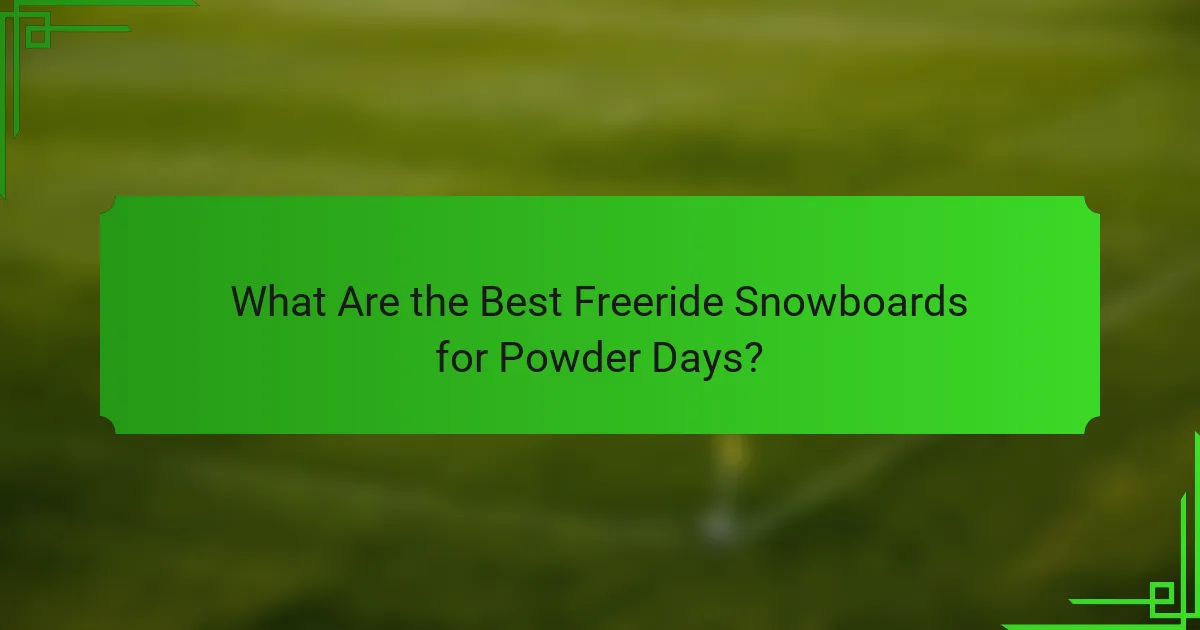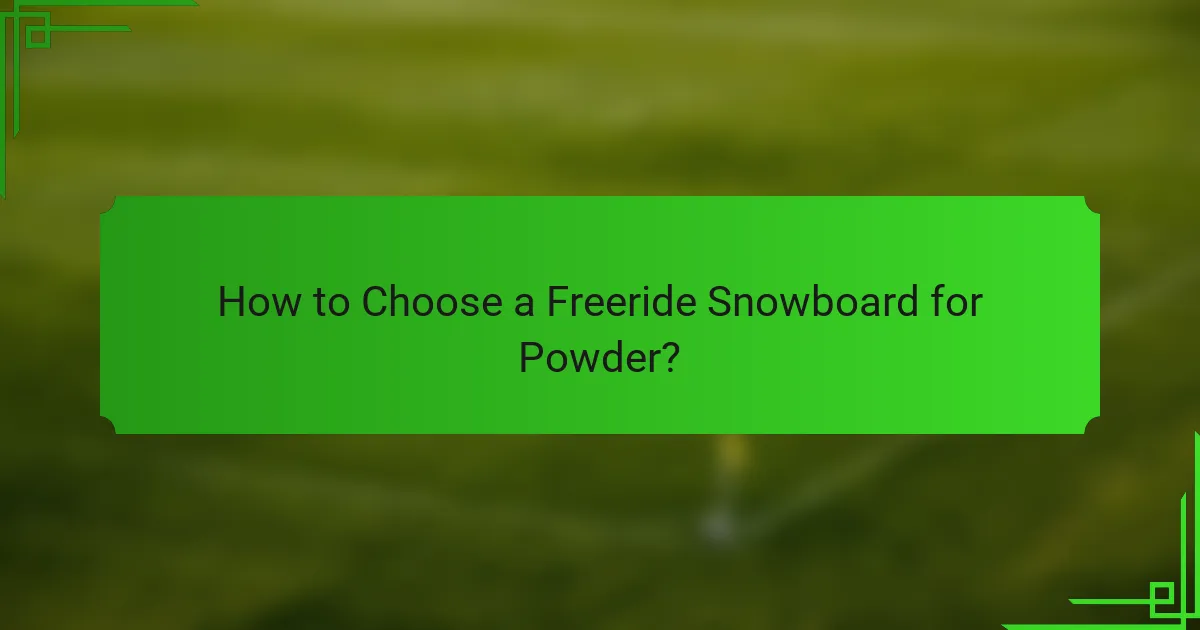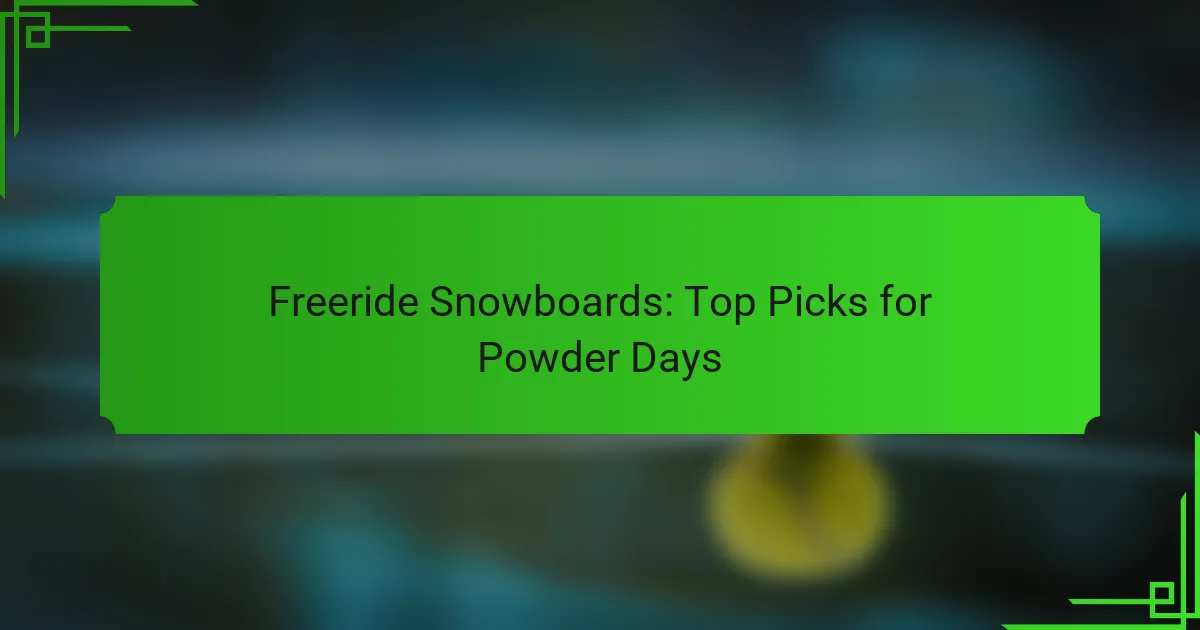When it comes to conquering powder days, selecting the right freeride snowboard is crucial for maximizing your experience on the slopes. These boards are specifically engineered to provide stability, float, and maneuverability in deep snow, making them ideal for off-piste adventures. Key features such as rocker profiles, width, and construction materials play a significant role in enhancing performance, ensuring you glide effortlessly through the powder.

What Are the Best Freeride Snowboards for Powder Days?
The best freeride snowboards for powder days are designed to excel in deep snow, offering stability, float, and maneuverability. Key features to consider include rocker profiles, width, and construction materials that enhance performance in off-piste conditions.
Burton Custom X
The Burton Custom X is a top choice for advanced riders seeking precision and speed in powder. Its directional shape and stiffer flex provide excellent stability, allowing for aggressive turns and control in variable conditions.
This board features a lightweight construction with carbon fiber reinforcement, enhancing responsiveness without sacrificing durability. Riders appreciate its ability to float effortlessly in deep snow while maintaining edge hold on hardpack.
Jones Flagship
The Jones Flagship is renowned for its versatility and performance in powder. With a directional rocker profile and a wide nose, it excels at floating over deep snow while providing a stable platform for carving.
This snowboard is built with eco-friendly materials and a durable construction, making it a reliable option for those who prioritize sustainability. Its responsive flex allows for quick adjustments, making it suitable for both steep descents and open powder fields.
Lib Tech T.Rice Pro
The Lib Tech T.Rice Pro is designed in collaboration with pro rider Travis Rice, making it ideal for adventurous freeriders. Its unique hybrid profile combines camber and rocker, offering both float and edge control in powder.
This board features a lightweight construction with environmentally conscious materials, ensuring performance without compromising the planet. Riders benefit from its playful nature, making it fun for tricks and jumps in powder conditions.
Salomon Sickstick
The Salomon Sickstick is a versatile freeride snowboard that thrives in powder and variable terrain. Its directional shape and medium flex provide a balance of stability and playfulness, making it suitable for various riding styles.
Equipped with a wide nose and a tapered tail, this board offers excellent floatation in deep snow. Riders appreciate its ability to handle both powder runs and groomed trails, making it a great all-around option for freeride enthusiasts.
Capita Black Snowboard of Death
The Capita Black Snowboard of Death is a powerful board designed for aggressive freeriders who seek performance in the most challenging conditions. Its stiff flex and camber profile provide unmatched edge control and stability at high speeds.
This snowboard features a unique construction that enhances durability while maintaining a lightweight feel. Riders can expect exceptional performance in deep powder, making it a favorite for those tackling steep lines and backcountry adventures.

How to Choose a Freeride Snowboard for Powder?
Choosing a freeride snowboard for powder involves understanding the board’s design, flex, and size to ensure optimal performance in deep snow. Focus on features that enhance floatation, stability, and maneuverability to maximize your experience on powder days.
Consider the Board Shape
The shape of a freeride snowboard significantly impacts its performance in powder. Boards with a directional shape, which are designed to ride primarily in one direction, typically offer better floatation and control in deep snow. Look for boards with a wider nose and a tapered tail to enhance buoyancy and reduce drag.
Additionally, boards featuring a rocker profile, where the center of the board is lower than the tips, can help with floatation. A combination of rocker and camber can provide a balance of stability and agility, making it easier to navigate through powder conditions.
Evaluate Flex and Stiffness
Flex and stiffness are crucial factors in how a snowboard performs in powder. Softer flex boards are generally more forgiving and easier to maneuver, which can be beneficial for beginners or those who prefer a playful ride. In contrast, stiffer boards provide better stability at high speeds and are ideal for aggressive riders tackling steep terrain.
When evaluating flex, consider your riding style and the conditions you typically encounter. A medium flex board often serves as a versatile option, allowing for a balance between playfulness and control.
Assess Size and Weight
The size and weight of a freeride snowboard affect its performance in powder. A longer board generally offers better floatation, while a shorter board can be easier to turn and maneuver. Aim for a board length that reaches between your chin and nose for optimal performance in powder.
Weight is also a consideration; lighter boards can be easier to handle and less tiring during long days on the mountain. However, ensure that the board’s construction is durable enough to withstand the rigors of freeriding in challenging conditions.

What Features Enhance Freeride Performance?
Freeride performance is significantly enhanced by features that improve stability, maneuverability, and floatation in deep snow. Key characteristics such as directional shape, rockered profiles, and wide nose designs are essential for optimal performance on powder days.
Directional Shape
A directional shape is designed to optimize the board’s performance in one direction, typically with a longer nose and a shorter tail. This design allows for better control and stability when navigating varied terrain and deep powder. Riders should consider boards with a pronounced directional shape for enhanced performance in freeride conditions.
When selecting a board, look for a directional shape that suits your riding style. If you prefer aggressive turns and speed, a more pronounced directional shape can provide the edge you need. Conversely, if you enjoy a mix of freestyle and freeride, consider a board with a moderate directional shape.
Rockered Profile
A rockered profile features an upward curve in the nose and tail, which helps the board float on top of powder rather than sinking. This design allows for easier turn initiation and reduces the likelihood of catching an edge in soft snow. Riders should look for a board with a significant rocker if they frequently ride in deep powder.
There are different types of rocker profiles, including continuous and hybrid designs. Continuous rockers offer maximum float, while hybrid profiles combine rocker with camber for added stability and edge control. Choose based on your preference for maneuverability versus stability.
Wide Nose Design
A wide nose design increases surface area, enhancing floatation in powder and improving overall stability. This feature helps prevent the nose from diving into the snow, allowing for smoother rides in deep conditions. Boards with a wide nose are particularly beneficial for those tackling challenging terrain.
When evaluating a board, consider the width of the nose in relation to your foot size and riding style. A wider nose is advantageous for larger riders or those who prefer aggressive freeriding. However, ensure that the overall width of the board suits your balance and control preferences.

What Are the Price Ranges for Freeride Snowboards?
The price of freeride snowboards varies significantly based on features, materials, and brand reputation. Generally, you can expect to find options ranging from around $300 to over $1,000, with each price tier offering distinct advantages and performance characteristics.
Entry-Level Options ($300-$500)
Brands like Burton and K2 often have solid entry-level options. While these boards may lack some advanced features, they can still provide a fun and enjoyable ride on powder days.
Mid-Range Choices ($500-$800)
Mid-range freeride snowboards fall within the $500 to $800 bracket and are suitable for intermediate to advanced riders. These boards usually incorporate better materials and technology, enhancing performance in deep snow and varied terrain. Features like improved edge control and lighter construction can make a significant difference in your ride.
Models from brands like Lib Tech and Jones often fit into this category, offering a balance of quality and price. Investing in a mid-range board can elevate your experience, especially if you frequent backcountry or off-piste areas.
High-End Models ($800+)
High-end freeride snowboards are priced at $800 and above, designed for serious enthusiasts and professionals. These boards boast advanced technology, superior materials, and exceptional performance capabilities, making them ideal for tackling challenging powder conditions and steep terrain.
Brands such as Never Summer and Arbor offer premium options that feature cutting-edge designs and customizability. While the investment is significant, the enhanced performance and durability can be worth it for dedicated riders who prioritize quality and experience on the mountain.

Where to Buy Freeride Snowboards?
Freeride snowboards can be purchased at various locations, including local shops, online retailers, and specialized sporting goods stores. Each option has its advantages, such as personalized service at local shops or a wider selection online.
Local Snowboard Shops
Local snowboard shops are excellent places to buy freeride snowboards as they often provide expert advice and personalized recommendations. Staff members are typically passionate about snowboarding and can help you find the right board based on your skill level and riding style.
When visiting a local shop, consider trying out different models. Many shops offer demo days or rentals, allowing you to test boards before making a purchase. This hands-on experience can help you determine which freeride snowboard feels best for you.
Additionally, local shops often have knowledge of regional snow conditions and can recommend boards that perform well in local terrain. Look for shops that offer a good range of brands and models to ensure you find the perfect fit for your powder days.
